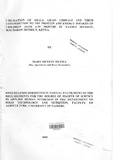Utilisation of small grain cereals and their contribution to the protein and energy intakes of Children aged 6-59 months in Yathui Division, Machakos District, Kenya.
Abstract
A cross sectional study which was descriptive in nature was carried out during the month of
September, 2004 among households with children aged 6-59 months in Kiunduani and
Itumbule sub-locations of Kibauni location, Yaihui division, Machakos district. The main
objective or the study was to determine the factors associated with production and utilization
of small grain cereals and their contribution to the protein and energy dietary intakes of
children aged 6 to 59 months.
The principal tool or investigation was a structured questionnaire that was administered to
mothers or children Care takers. Methods used were anthropometric measurements and
dietary intake recall. Purposive sampling was done at District and Division levels whereas
simple random sampling was done at location and sub-location levels. Systematic sampling
was done at household level giving a sample size 01'260 households. The inclusion criteria
was a child aged between 6-59 months. In households with more than one child at this age
category, only one child was picked randomly as the index child. A sub sample of 36
households was randomly selected for the 24-hour dietary recall. Data was collected with the
assistance or five field assistants. The SPSS computer package was used for data entry and
analysis. Nutritional status indices such as weight-for-age, height-for-age and weight-forheight
were computed using the Epi-info program.
The findings of the study indicate that there was no significant difference in production and
utilization of small grain cereals in households headed by people aged more than fifty years
-and those headed by people aged below fifty years. The same was realized when the male
and female headed households were compared indicating that the production and utilization
of small grain cereals is not determined by age or the sex of the heads of the households.
However, mean acreage of sorghum (0.4) was higher than that of finger millet (0.2).
Energy intake from sorghum/finger millet was significantly low (y-error bars not
overlapping) only among study children aged J6-59 months. This could be attributed to the
fact that as the children grow older, they take less porridge and hence less of the small grain
cereals. Protein intake from other foods by the study children was significantly higher than
that from sorghum an~1millets except for children aged 12-35 months. This could probably
be because ofthe fad that these children are within the weaning period.
There was no significant difference (p>0.05) in malnutrition rates among study children in
households which mixed the small grain cereals with other foods and those in households
where mixing was not practiced.
Finally, a significant relationship was noted between wasting, underweight and the
sorghum/finger millet calorie and protein intakes by the study children whereas stunting did
not show any relationship with the same. However, no signi ficant di fference was observed in
malnutrition of the study children among households , that produced the small grain cereals
and those which did not produce.
Citation
Muema, M. M(2005).Utilisation of small grain cereals and their contribution to the protein and energy intakes of Children aged 6-59 months in Yathui Division, Machakos District, Kenya.Sponsorhip
University of NairobiPublisher
Department of Food Science, Nutrition and Technology, University of Nairobi
Subject
Small grain cerealsProtein Intake
Energy Intake
Children
Yathui Division
Machakos District
Kenya
Description
Msc-Thesis

